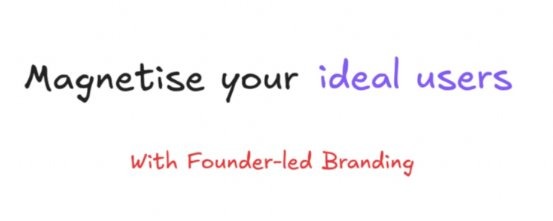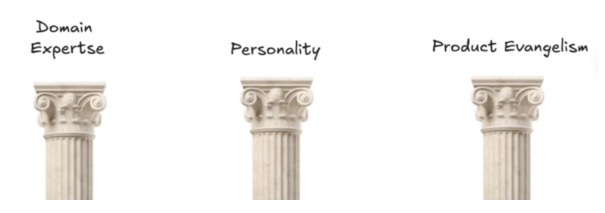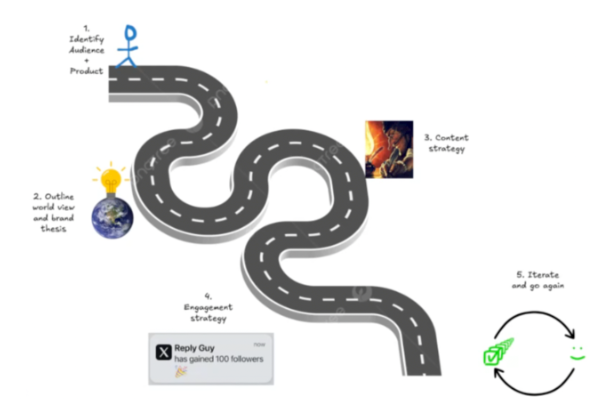People don’t buy products, they buy solutions

How do you build trust, create a compelling narrative, and acquire users for your product in a market that’s noisy, filled with copycats, and plagued by bad actors?
In crypto, most products look the same from the outside. A landing page, a token, maybe some tokenomics that look suspiciously similar to what came before. Rug pulls and vaporware have burned users, leaving an environment where credibility is scarce and skepticism is the default.
So the question becomes: how do you rise above the noise and show your solution is the best in the market? The answer is founder-led branding.
When executed well, founder-led branding is more than reputation management, it’s your distribution engine. It builds trust, frames your narrative, and earns visibility in a market where attention is fragmented and short-lived.
This is how founders transform themselves from anonymous profiles in a timeline feed into trusted voices in the market.
The market landscape
Crypto is not short on builders. Every day, new projects launch with promises to “redefine DeFi,” “rebuild social,” or “make NFTs great again.” The barrier to entry is low. Unless you’re creating a new Layer 1 or pushing the frontier of cryptography, most products rely on existing primitives like smart contracts, SDKs, or white-labeled infrastructure.
This means hundreds of lookalike projects flood the market. And when products are a commodity, everything looks the same, differentiation becomes harder.
The second reality is the size of the user base. It’s easy to assume adoption is massive when you zoom out and see billions of dollars locked in protocols. But the subset of true crypto-native users (i.e., those actively using DeFi, DAOs, NFTs, and dApps) is relatively small. This means competition for their attention is fierce.
And that’s before you factor in the distortions: bot farms, Sybil attacks, and accounts that exist only to chase incentives. Real users are harder to spot. For new projects, this makes building authentic traction a minefield.
Finally, there’s the broken state of marketing in the space. Too often, it’s reduced to shilling tokens, chasing vanity metrics, or throwing money into incentive programs that produce temporary activity but no loyalty. In a world where everyone is yelling, it’s the founder with the clearest story who wins.
That’s where founder branding becomes the lever.
Why founder-led branding matters
People don’t invest in faceless logos. They invest in people they believe in. People they believe are building a solution for them.
At an early stage, your product will rarely speak for itself. You may have an MVP, some early users, or a whitepaper, but that’s not enough to carry conviction. What users and investors buy into is the founder’s credibility. Just as venture capitalists are known to back founders first and products second, early adopters in crypto rally around builders they trust.
A founder brand serves as proof of seriousness in a market full of uncertainty. It says: I understand this problem. I’ve thought deeply about the solution. And I’m the person who can deliver it.
The benefits compound in three ways:
- Narrative building: Your personal voice sets the context for your company’s story.
- Attraction: Strong founder branding draws in users, investors, and potential collaborators.
- Differentiation: In a market flooded with similar ideas, the founder’s identity becomes the moat.
A founder who builds in public and communicates with clarity becomes a magnet for high-quality attention. That attention is what fuels early traction, fundraising momentum, and eventual distribution.
The three core pillars
The mechanics of building a founder brand rest on three interlocking pillars:

1. Domain expertise
The fastest way to build credibility is to show you know your arena. Share analysis, frameworks, or contrarian takes that reveal depth of thought. If you’re in DeFi, dissect token incentive structures. If you’re a CTO, break down consensus mechanisms or scaling trade-offs.
The signal here is originality. Retweets and platitudes don’t build authority. Critical thinking does. The goal is to be the founder who not only builds but also explains the “why” and “how” better than anyone else.
2. Product evangelism
Domain expertise without product narrative is incomplete. You need to connect the dots between the problem you’re discussing and the solution you’re building. This is where product evangelism comes in.
Instead of shilling, educate. Show live demos, walkthroughs, break down use cases, and explain how your product slots into the wider ecosystem. When you combine authority with storytelling about your product, you create a multiplicative effect: people don’t just trust your expertise, they trust your product because you are behind it.
3. Personality
This is the sticky layer. Again, people follow people, not faceless brands. Your quirks, humor, and human side make you relatable. The founder who posts about their gym routine, pet, or late-night coding sprint feels real, and real is what cuts through in a space drowning in surface-level noise.
This doesn’t mean oversharing or performative vulnerability. It means letting people see the human behind the project. When users feel like they “know” you, they’re more likely to believe in what you’re building.
Supporting pillars
The big three create the foundation, but three supporting levers complete the system.
1. Engagement
There are two modes:
- External engagement: reply to other builders, jump into trending discussions, and interact with thought leaders. This expands your surface area and puts your profile in front of audiences that don’t know you yet.
- Internal engagement: nurture your own replies, start real conversations in your community channels, and build relationships with people already following you.
Together, these keep the flywheel turning.
2. Narrative ownership
Every founder brand must answer two questions consistently: Why now? Why us?
That clarity creates a sense of inevitability, the feeling that your company is not just solving a problem, but solving it at the exact right time. The sharper your narrative, the easier it is for others to echo it back.
3. Brand vs shilling
There’s a crucial difference between branding and shilling. Branding builds long-term credibility, while shilling burns trust for short-term noise. Distribution without trust is wasted surface area. Credibility first, distribution second.
Step-by-step roadmap
If you’re building your founder brand from scratch, here’s a roadmap:

- Clarify product & audience: Define exactly who you serve and how you’ll frame your product for them.
- Define worldview & brand thesis: Articulate 3–5 core ideas you want to be known for. This becomes the foundation of your narrative.
- Content strategy: Balance the three pillars. Mix domain expertise (aka thought leadership), product evangelism, and personality. Two to three strong posts a week are better than ten low-signal ones. Share lessons, failures, and origin stories.
- Engagement strategy: Build lists of accounts to engage with. Mix niche players (for credibility) and bigger names (for reach). Balance external engagement with nurturing your own community.
- Feedback loop: Track what resonates, iterate quickly, and cut what doesn’t. Content strategy isn’t set-and-forget. It’s ready → fire → aim → repeat. The founder brand is never “done.” It’s a system of iteration. The more you test, the sharper your signal becomes.
Final thoughts
Crypto is a people-first game. Behind every product, protocol, or marketplace is a founder, and it’s that founder who users decide to trust (or ignore).
When domain expertise, product evangelism, and personality come together, you don’t just create content. You build trust, narrative, and visibility that compound over time. And in Web3, compounded trust is the most valuable distribution engine you can own.
If you want help defining your narrative and executing founder-led marketing that drives growth, DM us to book a free call.

